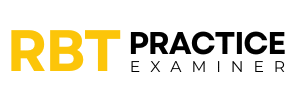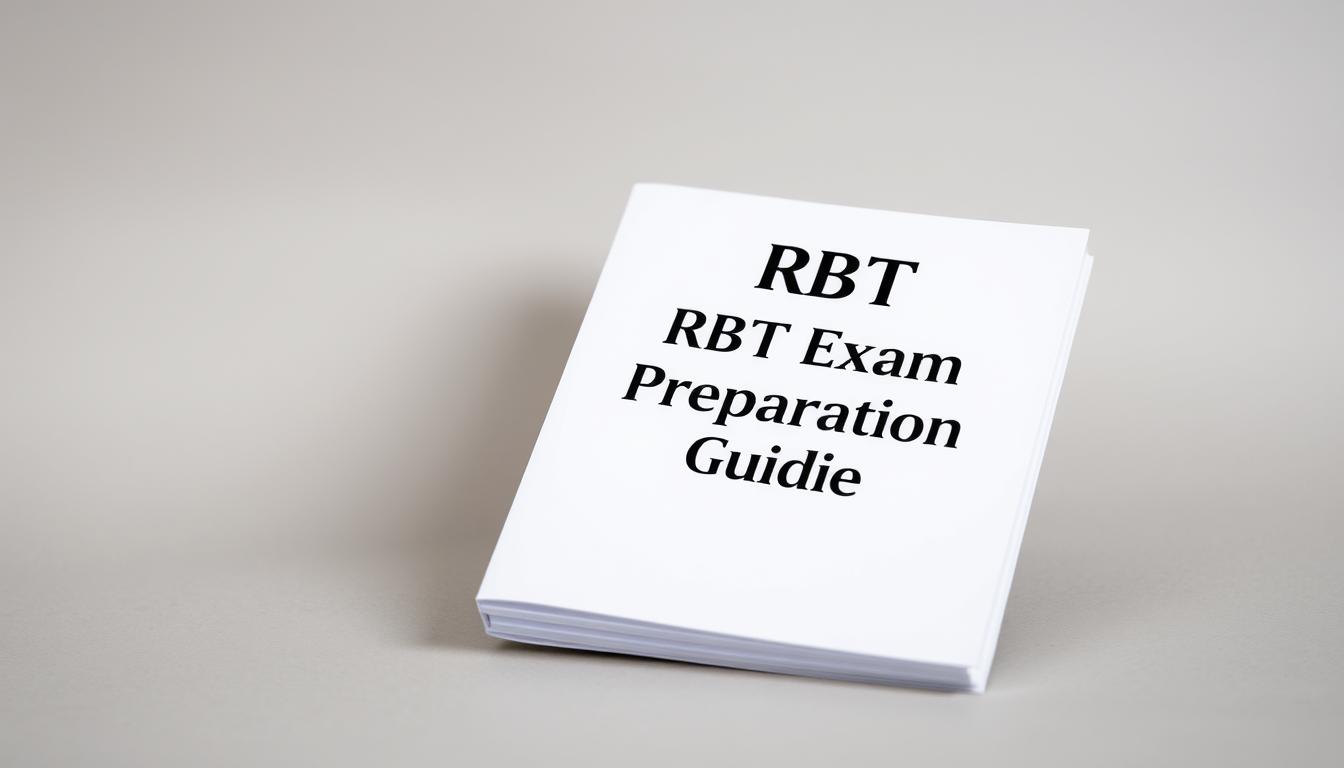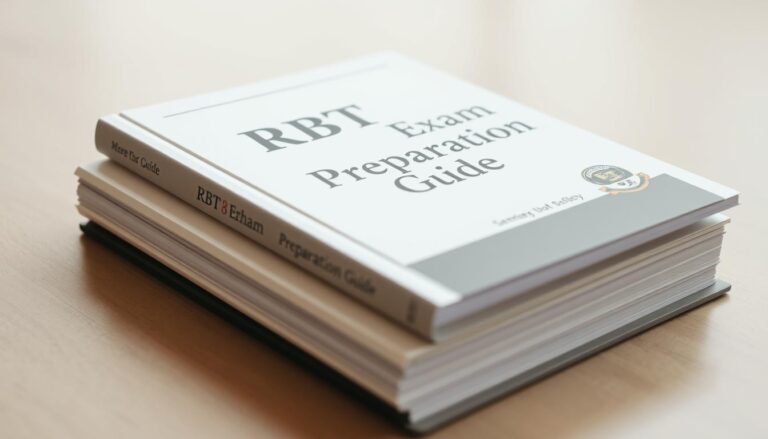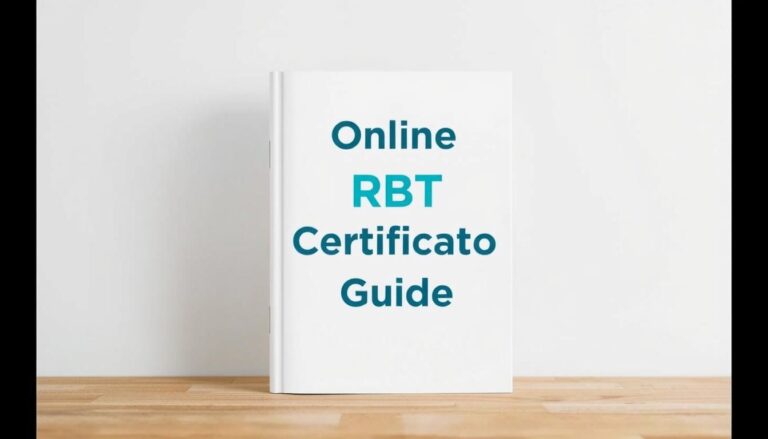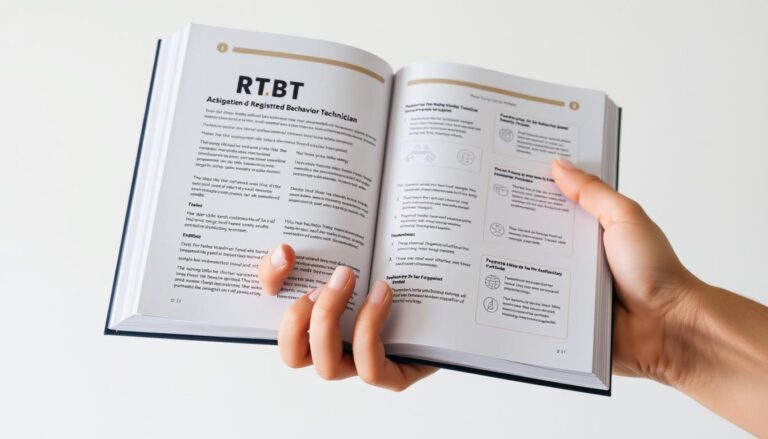RBT Exam Prep: Everything You Need to Know to Pass
Starting your journey to become a Registered Behavior Technician (RBT) can seem tough. But with the right prep, you can conquer this challenge. To get certified, you need to study hard and plan well.
To ace the RBT exam, you must know the task list inside out. You also need to master key techniques and have a solid study plan. If you want to pass, you must commit to thorough review and practice.
This guide will cover all you need to know about RBT certification. We’ll talk about what the exam requires, how to study, and share tips to help you succeed. Whether you’re new to the field or looking to grow, we’ve got you covered.
Passing the RBT exam is all about preparation. Our expert tips will help you learn and feel ready. You’ll show off your skills and become a certified RBT.
Understanding the RBT Certification Process
Becoming a Registered Behavior Technician (RBT) is an exciting journey for those passionate about applied behavior analysis. This certification opens doors to meaningful careers supporting individuals with developmental challenges. Understanding the RBT exam requirements and developing a study guide are key steps in your professional development.
What is an RBT Certification?
An RBT certification is a critical entry-level credential in behavioral health. Professionals with this certification work directly with clients under the supervision of a Board Certified Behavior Analyst (BCBA). It shows a standardized level of competence in implementing behavior intervention plans and collecting critical data.
BACB Requirements and Eligibility
To qualify for the RBT certification, candidates must meet specific Behavior Analyst Certification Board (BACB) standards:
- Be at least 18 years old
- Hold a high school diploma or equivalent
- Pass a background check
- Complete 40 hours of trained fieldwork
- Pass a professional competency exam
Career Benefits of RBT Certification
Pursuing RBT certification offers many professional advantages. Professionals gain valuable experience in behavioral intervention. They also expand their career opportunities in healthcare and education. They develop specialized skills in supporting individuals with autism and other developmental disabilities.
The certification not only enhances your professional credentials but also provides a solid foundation for advanced careers in applied behavior analysis. Many professionals use the RBT certification as a stepping stone to become Board Certified Behavior Analysts.
Essential Prerequisites for the RBT Exam
To prepare for the Registered Behavior Technician (RBT) exam, you must meet certain requirements. Knowing these steps is key to a smooth certification journey.
The Behavior Analyst Certification Board (BACB) sets clear rules for RBT exam eligibility. To qualify, candidates must fulfill several important criteria:
- Minimum age of 18 years old
- High school diploma or equivalent educational credential
- Completion of 40-hour RBT training program
- Passing a background check
- Supervised competency assessment by a Board Certified Behavior Analyst (BCBA)
The rbt exam requires a thorough background screening. Candidates must pass a criminal background check. This ensures client safety and upholds professional standards in applied behavior analysis.
Training is a critical component of RBT exam preparation. The 40-hour training program teaches vital skills and knowledge. It includes:
- Measurement of behavior
- Assessment procedures
- Behavior reduction techniques
- Documentation practices
- Professional conduct and ethics
Aspiring RBTs should document their training and ensure all requirements are met before the exam. Keeping records of your training, supervision, and background check will help you through the certification process.
How to Take RBT Exam: Step-by-Step Guide
Getting ready for the RBT exam can seem tough. But with the right help, you’ll be ready to start your certification journey. Knowing how to take the RBT exam means planning well and paying attention to details.
Before you start the exam process, you need to do a few important things. These steps help make sure your RBT exam scheduling and registration go smoothly.
Creating Your BACB Account
Your first step is to make a Behavior Analyst Certification Board (BACB) account. Here’s what to do:
- Go to the official BACB website
- Click on “Create Account”
- Enter your personal info correctly
- Pick the RBT certification path
- Check your email to verify it
Scheduling Your Exam Date
Planning your RBT exam date is key. Keep these tips in mind when picking your exam time:
- Finish all needed training first
- Make sure you meet the eligibility criteria
- Choose a testing center that’s easy to get to
- Pick a date that lets you study enough
- Book your exam on the BACB portal
Testing Center Requirements
Getting ready for your exam day means knowing what the testing center needs. Make sure to bring:
- A valid photo ID from the government
- Your exam confirmation details
- Any personal items allowed by the testing center
By following these steps, you’ll be well-prepared for your RBT exam. You’ll move through the certification process with confidence and professionalism.
RBT Exam Format and Structure
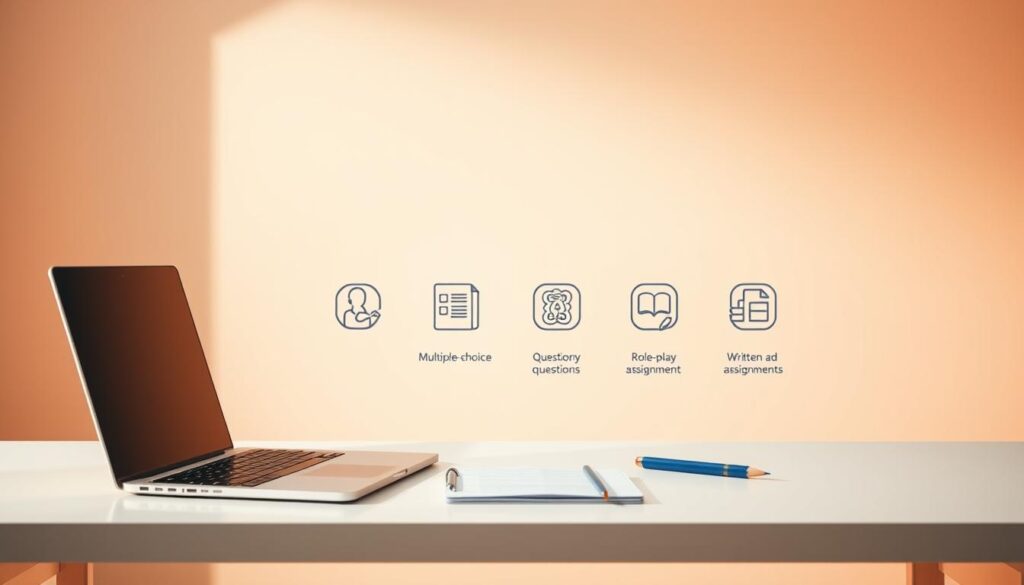
Getting ready for the Registered Behavior Technician (RBT) exam means knowing its format and structure. It’s designed to check your skills in applied behavior analysis. This ensures you’re set for professional work.
The RBT exam has key parts that test your grasp of behavioral intervention methods. If you want to be an RBT, it’s important to know these tips for the exam.
- Exam Length: 80 multiple-choice questions
- Total Testing Time: 2 hours
- Passing Score: 80% or higher (64 correct answers)
The exam looks at six main areas of behavioral analysis. You’ll face questions based on real-life scenarios. These test how well you apply what you know.
Exam Content Breakdown
- Measurement and Assessment
- Behavior Reduction
- Skill Acquisition
- Documentation and Reporting
- Professional Conduct
- Ethical Considerations
To ace the RBT exam, you need to grasp these content areas. Use practice tests and focused study to get used to the exam’s style and time limits.
Breaking Down the RBT Task List
To pass the RBT exam, you need to know the task list well. A good study guide should cover all important areas. These areas show your skills in applied behavior analysis.
The RBT task list has three main areas. These areas are key for doing well on the exam. They test your skills in using basic behavioral analysis in real life.
Measurement and Assessment
This section is very important. You need to show you can collect and analyze behavior data well. Key skills include:
- Implementing precise data collection methods
- Understanding graphing and visual representation of behavior
- Recognizing different measurement techniques
Behavior Reduction
Knowing how to reduce bad behaviors is key for RBTs. The exam checks your knowledge of:
- Identifying problematic behaviors
- Implementing intervention strategies
- Monitoring behavior change effectively
Documentation and Reporting
Keeping accurate records is very important in behavioral analysis. Your study guide should focus on:
- Creating clear, concise client records
- Following ethical documentation standards
- Communicating progress reports professionally
Learning these task list parts well will help you feel ready for the RBT exam. It ensures you go into the test with confidence and all the knowledge you need.
Time Management Strategies for Exam Day
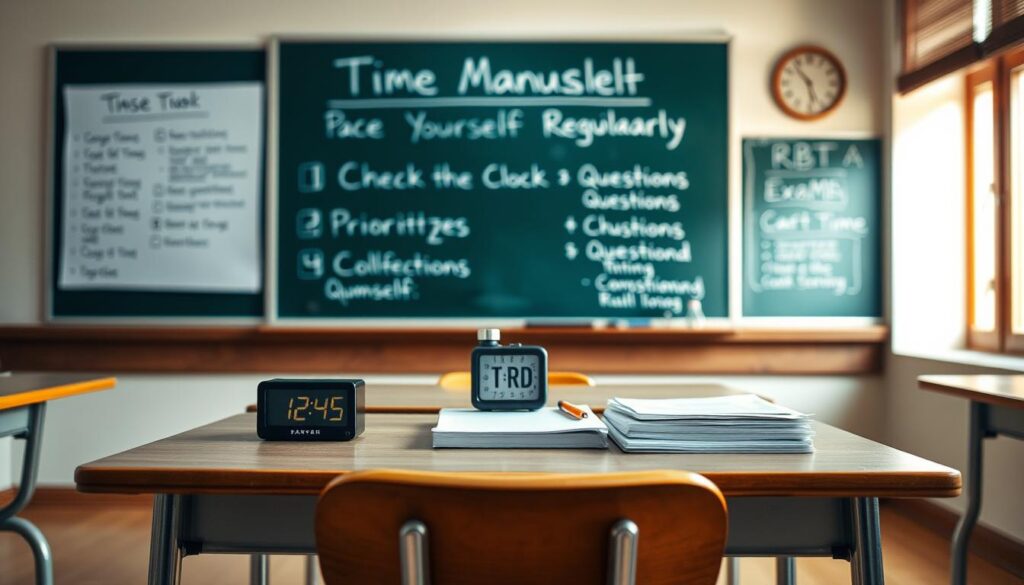
Mastering time management is key for your RBT exam. Good rbt exam tips can change how you feel about the test. It’s all about planning well to get through it smoothly.
Focus on three main goals for your time strategy:
- Know the exam layout
- Practice how to pace yourself
- Plan out how to answer questions
On the RBT exam day, use certain tips to do your best. First, quickly look over the whole test to see how hard the questions are. This helps you plan and focus your time better.
Here are some useful time management tips:
- Set time limits for each part
- Mark hard questions for later
- Use the exam clock to keep track of time
- Save 10-15 minutes for a final check
Staying calm and focused is very important. If a question is tough, don’t get stuck. Move on and come back to it if you can. Your aim is to answer as many questions right as you can in the time allowed.
By practicing these rbt exam tips, you’ll feel more confident and ready for time management on the big day.
Most Challenging RBT Exam Topics
Getting ready for the RBT exam needs careful study and a deep grasp of tough areas. Those who pass know some topics need more focus. By mastering these complex parts, you boost your chance to pass the RBT exam.
Common Misconceptions
Many future RBTs face several big misconceptions. Knowing these traps is key to good study plans.
- Misinterpreting behavior reduction techniques
- Overlooking precise documentation requirements
- Confusing data collection methods
- Misunderstanding ethical guidelines
Frequently Missed Questions
Some parts of the exam always give students trouble. RBT exam practice questions show where students often struggle.
- Functional behavior assessment interpretation
- Measurement and data collection accuracy
- Behavior intervention strategy selection
- Ethical decision-making scenarios
Areas Requiring Extra Focus
To get ready for the exam, focus on these key areas:
- Detailed understanding of applied behavior analysis principles
- Precise implementation of intervention strategies
- Comprehensive documentation practices
- Ethical considerations in behavioral treatment
By spending more time on these tough topics, you’ll feel more confident. This targeted effort will help you pass the RBT exam. Remember, understanding complex ideas is essential for getting certified.
RBT Exam Cost and Financial Planning
Planning your finances for the RBT exam is key. Knowing the cost is essential for those aiming to become behavior technicians. This career path is in applied behavior analysis.
The main costs for getting RBT certified are:
- BACB Application Fee: About $50
- Initial Exam Registration: Around $85
- Training and Study Materials: $100-$300
- Background Check: $20-$50
Those aiming for RBT certification should budget for $250 to $500 in initial costs. The cost can change based on training needs and personal prep.
Here are ways to plan your finances for RBT certification:
- Look into employer reimbursement programs
- Check for scholarships
- Use free or low-cost study resources online
- Save money for certification costs
Some groups offer payment plans or funding for professional growth. Local behavioral health agencies or schools might help with financial aid for the RBT exam.
Getting certified is a smart career choice. Even though it costs upfront, the benefits of being a certified Registered Behavior Technician are worth it in the long run.
Effective Study Materials and Resources
Getting ready for the RBT exam needs a smart study plan. It’s important to pick the right study guide and practice tools. A good plan should cover all key areas of the RBT Task List.
Recommended Study Guides
Choosing the right study materials is key. Look for guides that offer:
- Detailed content that matches the BACB task list
- Clear explanations of ABA basics
- Practice questions that feel like the real test
- Current info on behavior analysis methods
Online Practice Tests
Online tools can really help you get ready. Look for sites that offer:
- Full-length practice exams
- Quick scores and feedback
- Details on each question
- Smart learning tech
Study Groups and Forums
Learning with others can be very helpful. Joining with other RBT candidates offers many benefits:
- Shared tips and study plans
- Support and motivation
- Different views on tough topics
- Emotional support while studying
The best study plan uses many resources. Mix different study guides, practice tests, and group learning. This way, you can make a study plan that fits you best.
Practice Test Strategies and Tips
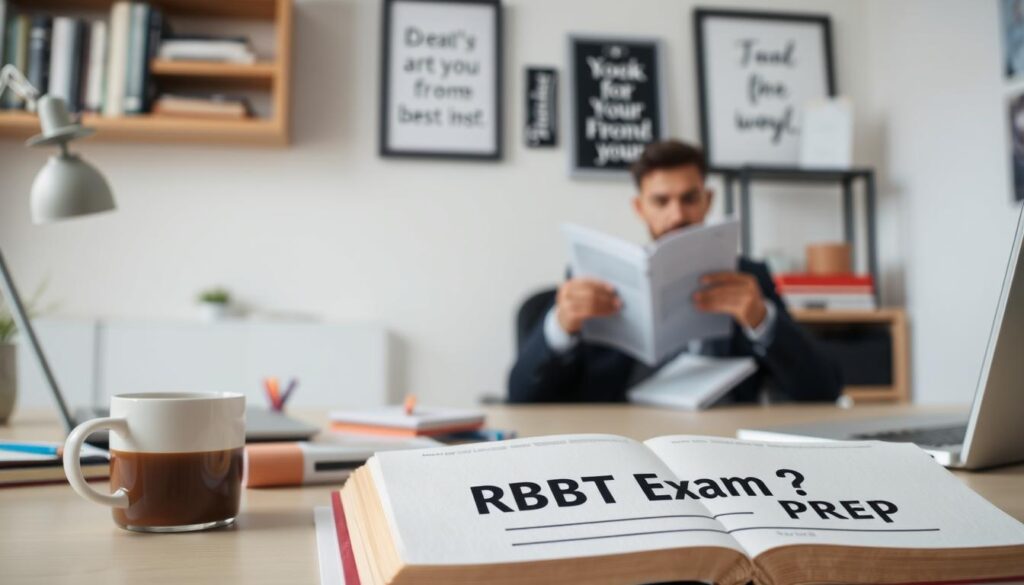
Mastering rbt exam practice questions is key. Practice tests help build your confidence and spot areas you need to work on. They are your best tool before the RBT certification exam.
Start by creating a real testing environment. This means:
- Finding a quiet spot with few distractions
- Using a timer to keep track of time
- Practicing with full mock exams
- Setting up like the real testing center
When you do practice questions, think about why an answer is right or wrong. This helps you understand the concepts better and improves your grasp of behavioral analysis.
Here are some tips to do well on practice tests:
- Go over each test carefully
- Study your mistakes well
- Make a study plan for weak spots
- Keep track of your progress over time
Managing your time well is important. Use practice tests to find your pace. Try to spend less than a minute on each question. Save time for the tough ones.
Practice tests are more than just tests. They show you what you don’t know, boost your confidence, and help you understand the RBT task list better.
Day-Before Exam Preparation Guide
Getting ready for your RBT exam needs a good plan and smart tactics. The day before can really affect how well you do and how confident you feel. It’s important to get both your mind and body ready to do your best.
To pass the RBT exam, you need a complete plan that’s more than just studying. Your last 24 hours can greatly improve your results.
Mental Preparation Techniques
Getting your mind ready is key to doing well on the exam. Here are some tips to help you relax and feel more confident:
- Practice deep breathing exercises
- Visualize yourself successfully completing the exam
- Review key concepts without overwhelming yourself
- Get enough rest and avoid too much studying at the end
Physical Readiness Checklist
How you feel physically can also affect your exam score. Here’s what to do:
- Make sure you get 7-8 hours of sleep without interruptions
- Eat a healthy, balanced meal
- Drink plenty of water all day
- Choose comfy clothes for the exam
Required Documentation Preparation
| Document Type | Requirements |
|---|---|
| Government-issued ID | Valid photo identification |
| BACB Confirmation | Printed exam authorization |
| Additional Identification | Secondary form of ID recommended |
Pro tip: Check all your documents the night before to avoid stress on exam day.
Common Mistakes to Avoid During the Exam
Getting ready for the RBT exam needs careful planning and knowing what to avoid. Many people make mistakes that can hurt their scores. It’s important to know these mistakes to pass the RBT exam.
When you’re taking the RBT exam, remember to avoid these big errors:
- Rushing through questions without careful reading
- Failing to manage time effectively
- Second-guessing initial correct answers
- Neglecting to review answered questions
To pass the RBT exam, you need a smart plan. Here are some tips to help you avoid common mistakes:
- Read each question carefully – Understand the full context before selecting an answer
- Practice time management during mock exams
- Trust your initial knowledge and preparation
- Use the process of elimination for challenging questions
Staying calm and focused is key to avoiding mistakes. You should aim for a clear mind during the exam.
| Common Mistake | Prevention Strategy |
|---|---|
| Panic and anxiety | Deep breathing techniques, positive visualization |
| Incomplete question analysis | Systematic question breakdown, careful reading |
| Time mismanagement | Practice timed mock exams, watch clock carefully |
By knowing and avoiding these common mistakes, you’ll greatly boost your chances of passing the RBT certification exam.
Post-Exam Steps and Certification Maintenance
After you pass the RBT exam, you start a new chapter in your career. It’s important to know what to do next to keep your certification. This will help you grow in the field of applied behavior analysis.
It takes a few weeks to get your exam results. The Behavior Analyst Certification Board (BACB) will email you about your score. If you pass, you’re on your way to becoming a certified Registered Behavior Technician.
Certification Maintenance Steps
- Complete initial paperwork with BACB
- Register your official certification
- Secure ongoing professional supervision
- Track continuing education requirements
To keep your RBT certification, you must follow a few important steps. You’ll need to get the right supervision and keep up with training. This keeps your certification active.
Renewal Requirements
| Requirement | Details |
|---|---|
| Supervision Hours | Minimum 5% of direct client contact hours |
| Certification Renewal | Annual renewal required |
| Continuing Education | Minimum 4 hours of professional training |
Staying committed to learning helps you meet RBT exam requirements. This ensures you keep providing top-notch behavioral intervention services.
If you don’t pass the exam the first time, don’t worry. You can try again after a while. Use your past experience to improve your next attempt.
Conclusion
Mastering the RBT exam needs careful planning and hard work. Your path to RBT exam success is more than just memorizing facts. It’s about understanding applied behavior analysis well and showing you can work with people with autism.
We’ve shared strategies to help you pass the RBT exam. You now know how to prepare, from the exam format to practice tests and study tools. These insights will guide you on your certification journey. Remember, consistent study, practical use of concepts, and staying focused are key to reaching your goals.
Becoming a Registered Behavior Technician is a step towards a fulfilling career. Your hard work in preparing for the RBT exam shows your dedication to helping others. Trust in your training, stay confident, and know you’re ready to do well.
Keep learning and growing in applied behavior analysis. Your certification is just the start of a rewarding career. It lets you help people with special needs and make a real difference.
